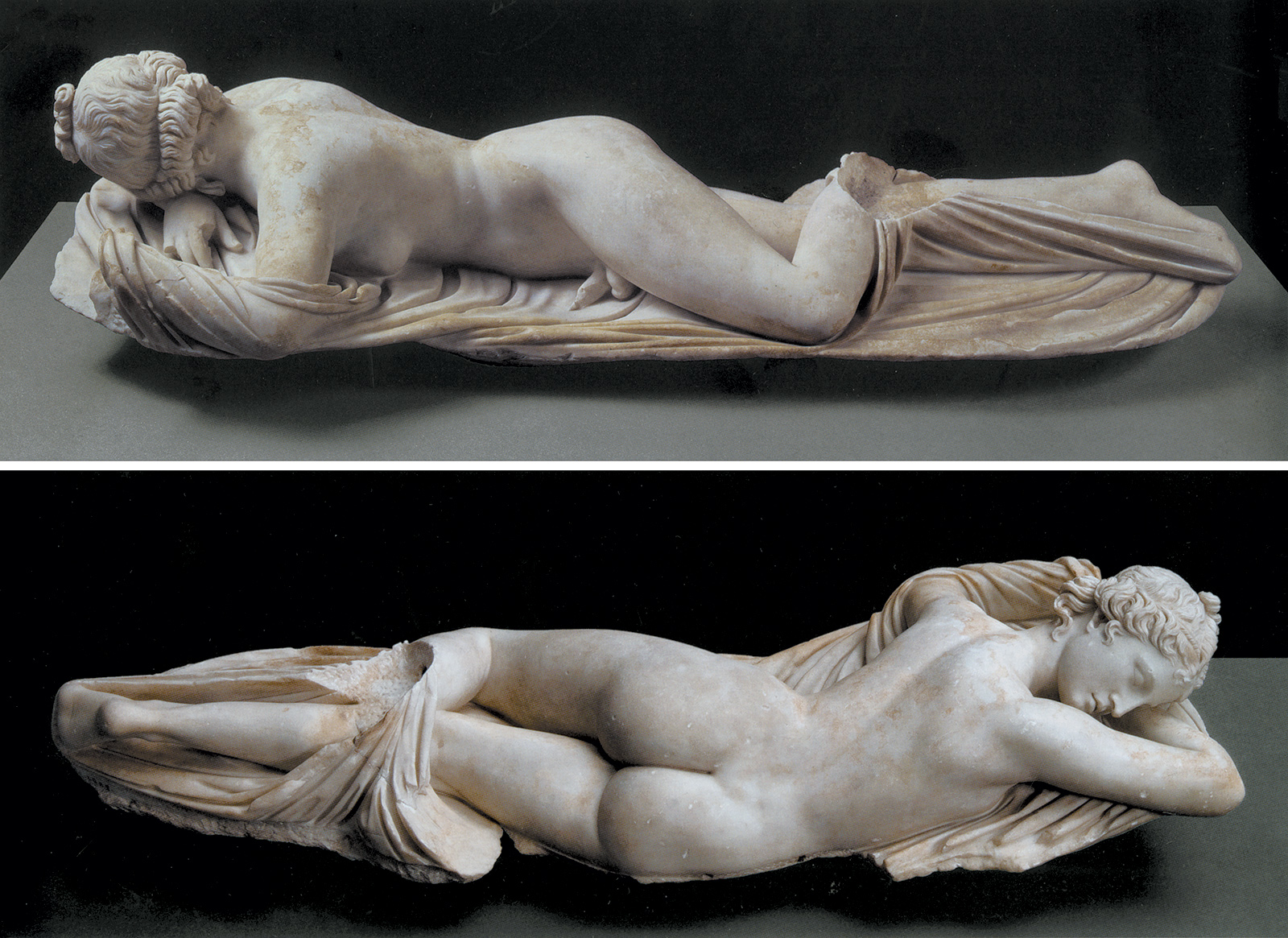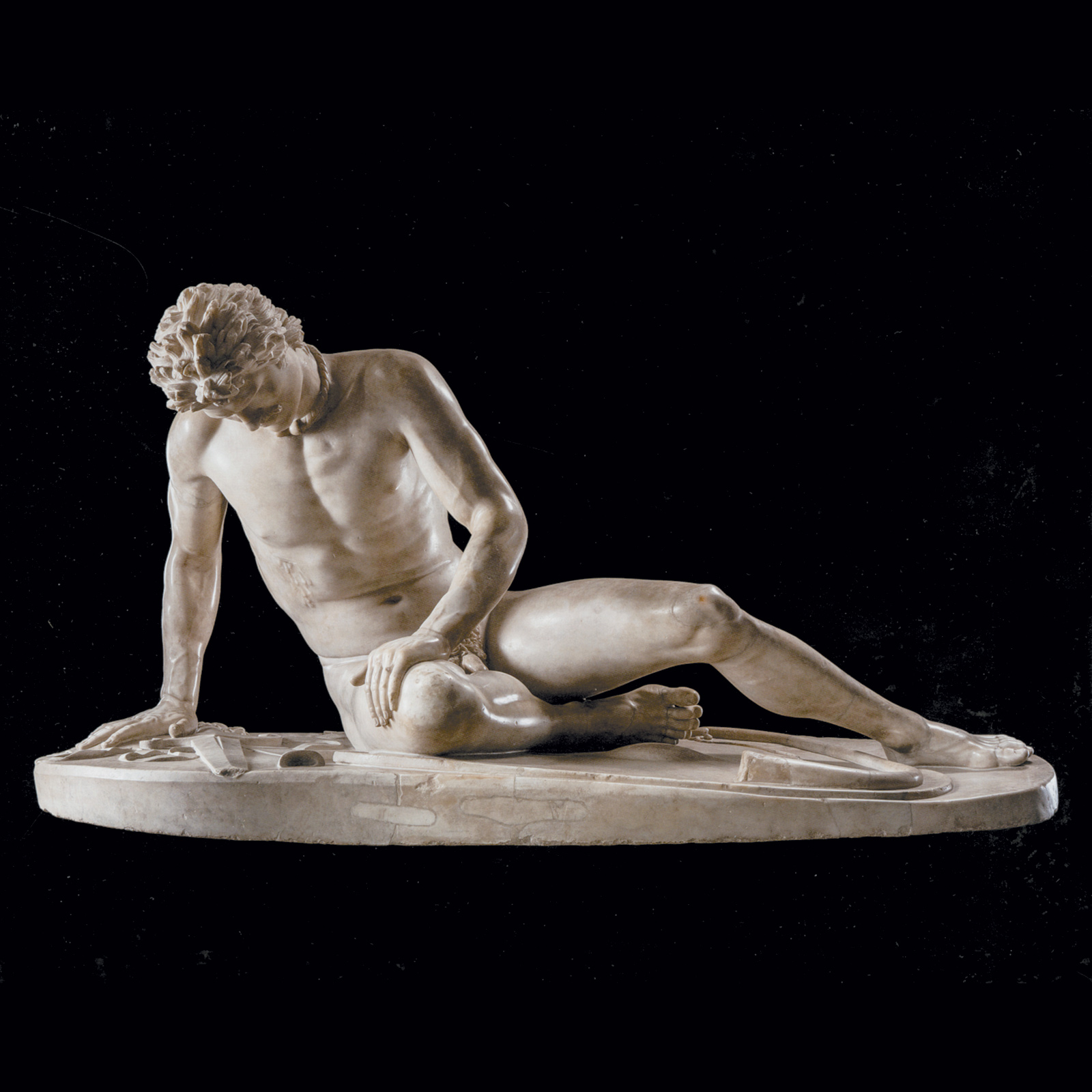In January 1880 the great Russian novelist Ivan Turgenev, author of Fathers and Sons and one of the most cosmopolitan Russian writers of the time, was visiting Berlin, when he paid a visit to the Altes Museum. What he saw there not only made a profound impression upon him personally but marked the beginning of a momentous transformation in European understanding of the art and culture of the ancient Mediterranean world. He had been standing before a group of monumental reliefs that German archaeologists, after complex negotiations with the Ottoman sultan, had recently imported from the upper city, or citadel, above the small village of Bergama in western Turkey, north of Smyrna (Izmir). Turgenev was ecstatic, and in March of the same year he published his reaction in a rapturous article that appeared in a liberal journal devoted to European culture, Vestnik Evropy (European Herald).
The reliefs were panels from a vast frieze on a huge altar that in the second century BC stood high above Bergama on its ancient acropolis, and they depicted with violent, interlocked, and sinuous images a mythical battle between Zeus and the Olympian gods against the rebellious Giants. These creatures were a race of monsters who were said to have emerged from Mother Earth after her son Cronos emasculated his father Ouranos (the sky), whose seed then inseminated the earth. Everyone knows that Zeus prevailed, but Turgenev could see from the Berlin reliefs that the struggle was not easy. As he described it, “An undoubted final victory, on the side of the gods, on the side of light, beauty, and reason—but the dark, wild forces of the earth still fight back, and the battle is not yet finished.” This epic tale, which had been spread out in dramatic detail across the altar frieze, moved Turgenev to observe at the end of his article, “Coming out of the museum, I thought how lucky I am not to have died without living long enough for these latest impressions and to have seen all this!”
The reliefs that had reached Berlin came from the ancient city of Pergamon, which had given the nearby village its modern name of Bergama. The breathtaking upper city, on the western slopes of which a magnificent classical theater still stands, served as the acropolis of the ancient city, where a sanctuary of the goddess Athena lay just above a great altar to Zeus. This was the monument from which the panels that so impressed Turgenev had come. The altar was open on the west with a massive staircase that led up between two walls on either side to a point where they joined with a back wall on the east. In its shape the whole edifice resembled an enormous chair, and it was for this reason that commentators on the “throne of Satan” at Pergamon, as mentioned in the Revelation of St. John 2.13, have suggested an allusion to precisely this monument. Even in antiquity a Roman author, Lucius Ampelius, had mentioned it as one of the marvels of the world: “In Pergamon there is a huge marble altar, forty feet tall with large sculptures: it also includes a Gigantomachy (Battle of the Giants).”
Visitors to the Metropolitan Museum’s current exhibition devoted to Pergamon and the Hellenistic kingdoms of antiquity can now recapture Turgenev’s excitement and exaltation, even though what is on display inevitably corresponds only in part to what he saw. Almost all the reliefs in 1880 had arrived in Berlin within the previous two years, after the opening of German excavations at the site in 1878. Over the decades that followed they were incorporated into a reconstruction of the Pergamon altar that has long been one of the glories of the Pergamon Museum in Berlin.
That museum is currently undergoing renovation, and this has allowed many of its objects, though obviously not the altar itself or most of the reliefs, to be lent to New York. The reliefs in New York are panels that show the birth and infancy of Heracles’ son Telephus, who was the mythical founder of the city. The Telephus reliefs come from the inner walls of the colonnade at the top of the altar, and so the Gigantomachy frieze has to be appreciated through photographs. But the curators of the exhibition have successfully combined the loans from Berlin with major pieces from many other collections so as to provide a wide-ranging exploration of the art and culture of the so-called Hellenistic world. This is the international milieu in which Pergamon shone brightly and to which Rome was much indebted.
Hellenistic culture is often misunderstood and confused with Hellenic (or Greek) culture. Yet it is very different, though related. It is a culture that derives from the conquests of Alexander the Great, who, under the inspiration of his teacher Aristotle, brought the legacy of classical Greece across Asia Minor, the Middle East, and India. The Metropolitan Museum has not only created a visual effect that would inspire a modern Turgenev, but it has given Hellenistic art, which lies between the art of classical Greece and that of Rome, the prominence it amply deserves. It does this through a conjunction of portrait busts, statuary, reliefs, and smaller objects, including many fine coins, glass bowls, gold jewelry, a superb onyx cameo from Vienna, an exquisite mosaic from Pompeii with itinerant musicians wearing masks, and much else.1 Photomurals provide views of the grandiose setting of Pergamon, from its highest point, including the great altar, all the way down to the lower city where a sanctuary of Asclepius, the god of medicine, was to become a popular resort for the sick in search of cures in the second century AD.
Advertisement
The concept of Hellenistic civilization began with Johann Gustav Droysen in the nineteenth century. This formidable classical scholar, who was the tutor and friend of the young composer Felix Mendelssohn and a devout Lutheran, achieved a lasting impact through his recognition that the centuries from the death of Alexander in 323 BC to the establishment of the Roman Empire in 27 BC witnessed something altogether new in Mediterranean antiquity. In 1833 Droysen published a pioneering volume about Alexander’s career. In it he described a fusion of Greek, or Hellenic, culture with the cultures that lay farther east—in western Asia Minor, Egypt, Palestine, Syria, Iran, and India.2 Alexander not only created an unparalleled empire over which he briefly presided in his short life, but he altered forever the local cultures of those regions through which he passed. Droysen had wanted to understand all this in a search for the origins of Christianity, which had emerged precisely after the end of the period that interested him. But his religious motivation did not seriously distort his exhaustive account of the new world that Alexander shaped, and his work remains definitive to this day.
After the book on Alexander in 1833, Droysen turned to an account of Alexander’s successors and the eventual formation of their four eastern kingdoms after his death. These were in Macedonia, Egypt, Syria, and western Asia Minor. The Antigonids, from the family of Alexander’s general Antigonus the One-Eyed, assumed control in Macedonia, the Ptolemies became rulers of Egypt, Seleucus took over greater Syria to constitute a Seleucid kingdom, and finally Philetairos, the son of Attalus, took possession of Pergamon. Droysen chose to call the culture of the three centuries after Alexander Hellenismus in German, to signal its origins in mainland Greece; but neither the concept nor the word can be equated with Hellenism, and so it has come to be known in English and other languages as Hellenistic culture.
In two volumes entitled Geschichte des Hellenismus (Hellenistic History), published in 1836 and 1843, Droysen developed his grand and innovative theme. By 1877 he had revised his original history of Alexander the Great to convert it into what then became the first of a three-volume edition of his Hellenismus. The four Hellenistic kingdoms had little in common apart from their indebtedness to Alexander and his extraordinary union of Greek and Eastern cultures. But they grew together in a kind of symbiosis, sharing interests and styles such as the formation of great libraries in both Egypt and Pergamon, and the evolution of a florid and romantic representation of human figures that went back to the earliest flamboyant portraits of Alexander himself on his coinage. It is the art of this age that greatly impressed the Romans as they gradually extended their power across the eastern Mediterranean.
Romans knew and admired classical Greek sculpture, which they always felt free to carry off as booty during the course of their conquests. But they also promoted a lively commerce in copies of classical pieces together with new work in the more extravagant Hellenistic style. These commercial objects provided the Romans with ornamental art for their villas and gardens. At the Villa of the Papyri in Herculaneum, near Pompeii, more than forty busts of Greek intellectuals—philosophers and poets—and Hellenistic rulers adorned a garden through which trickled a small stream of refreshing water. The New York galleries include a substantial number of these pieces, from which Roman generals, orators, and poets are conspicuous by their absence. It was Roman taste that created the Hellenistic art market.
The Metropolitan’s exhibition reveals Rome to have been a kind of engine that drove the production of copies of classical art, as well as the design of new pieces of Hellenistic art and, subsequently, copies of Hellenistic art. The pieces made in the Hellenistic regions were normally dispatched by sea to Italy because overland transport of objects in bulk was not a commercial option, but on occasion shipwrecks disgorged into the watery depths the precious objects they were transporting. The exhibition and its catalog present notable treasures that were retrieved from shipwrecks at Mahdia off the coast of Tunisia, Artemision off the northern coast of the Greek island of Euboea, and Antikythera off the southern coast of Greece. In the midst of its glass bowls and its marble and bronze sculptures the Antikythera wreck also brought to light a complex computing mechanism, with interlocking gears, that seems far in advance of its time. A reconstruction of the mechanism will be featured in a forthcoming exhibition at New York University’s Institute for the Study of the Ancient World, “Time and Cosmos in Greco-Roman Antiquity,” opening in October.
Advertisement
If Pergamon is the most conspicuous of the Hellenistic kingdoms to which the title of the exhibition alludes, that is only because the city itself and its art are so much more visible, thanks to the excavation at the site itself, than the surviving remains of the Antigonids, Ptolemies (with the exception of Alexandria), or Seleucids. When the Antigonid kingdom came to an end in 168 BC, only Ptolemaic Egypt could compete with Pergamon. Egypt had its great library at Alexandria along with a group of brilliant scholars who were toiling away on manuscripts of Homer and other literary texts. Yet although the Ptolemaic kingdom survived down to the suicide of Cleopatra in 30 BC after the Battle of Actium, its cultural influence had long been in decline. As for the Seleucids in Syria, Pompey stamped them out in 63 BC, when Syria became a Roman province.
But Pergamon’s fate was surprisingly different. The old king Attalus III, in an unexpected and unprecedented act of goodwill toward Rome, had bequeathed his entire kingdom to Rome in 133 BC. The Pergamene kingdom was then transformed into a Roman province, while the city of Pergamon itself preserved intact the monumental splendor of its citadel and its surrounding holy places. As visitors now walk through the exhibition galleries at the Metropolitan Museum, they can observe the mutual attraction between the burgeoning Roman republic after 133 BC and the former Pergamene kingdom. What is so hypnotic about the objects on display is the constant interaction of Pergamene style with Roman taste. This by no means stopped with the end of Droysen’s Hellenismus at the accession of Caesar Augustus in 27 BC.
The final galleries in the exhibition deliver us into the new age with an enigmatic bronze portrait bust of Juba II, the Augustan king of Mauretania (today’s Morocco). He is one of the emblematic figures of the newly formed Roman Empire. In his own person he sums up the complexity of the Mediterranean world that followed the Hellenistic kingdoms. He was a North African possessed of a curiosity and erudition that would have embarrassed even Saint Augustine, another North African of three centuries later. Juba presided over a realm at the southwestern corner of Rome’s empire where Greek was read and spoken, and through his marriage to Mark Antony and Cleopatra’s daughter he had acquired strong ties with Egypt and the eastern Mediterranean. He was a learned and multilingual scholar who furnished the results of his researches on Arabia to Augustus’s grandson, Gaius Caesar, as he was planning an expedition into the region. Juba’s kingdom was a kind of Hellenistic jewel box that kept Greek learning alive in the West even as the Roman government in Italy was growing increasingly autocratic.
Some Romans, including Augustus’s successor, the emperor Tiberius, shared Juba’s tastes, as the extraordinary sculptures inspired by the Odyssey, including the blinding of Polyphemus, have now revealed in the Italian grotto of Sperlonga. These sculptures represent styles of which Western Europe first became aware many centuries later, in 1506, with the discovery of the emotionally charged and thoroughly Hellenistic sculpture of Laocoön and his children in the coils of the snake that killed them. Juba’s young son Ptolemy, who took his name from his mother’s family, is also represented in the Metropolitan exhibition in an affecting bust from a private collection. This boyhood portrait with its firm but sad face seems to look forward to the cruelty of the later Julio-Claudian rulers. It was the emperor Caligula himself who had this young Ptolemy murdered.
Pergamon not only flourished but expanded as a part of the Roman Empire. A shrine to the emperor Trajan was constructed on the top of the citadel—high above the library, the shrine of Athena, and the great altar. In the lower city, close to the foot of the citadel, the ancient shrine of Asclepius was enlarged and became increasingly popular as a place for the sick to seek cures from the god. The Asclepieion grew to include a theater as well as a sacred enclosure in which ailing visitors could spend the night in order to learn directly from the god, who would visit them in dreams, how best to address their illnesses. These therapeutic dreams, induced by a process called “incubation” in the shrine, became so famous by the second century AD that the Pergamene Asclepieion had turned into a fashionable spa for Roman elites. Aelius Aristides, one of the era’s greatest Greek orators, was there so often that he wrote a series of discourses describing his incubations in the shrine.
Roman taste for Hellenistic art continued unabated throughout the imperial age. This meant the production of marble copies of bronze originals that are lost today. Some of the copies are now among the most famous of all examples of Hellenistic art. The Laocoön group was one of these, and others were the dramatic representations of Pergamum’s defeat of Celtic invaders into Asia Minor. These warriors were Gauls, known in the East as Galatians, who were turned back by Attalus II. The sculptors of his kingdom commemorated his success by depicting the deaths of individual Gauls in scenes of high pathos that marble copies for the Roman market have fortunately preserved.
The two greatest are still in Rome, the Dying Gaul in the Capitoline Museums and a piece in the Palazzo Altemps that shows a proud Gaul killing himself while holding the limp body of his already slain wife. The Dying Gaul appears in the Metropolitan catalog but never actually made it to the exhibition. Nevertheless, both sculptures are well illustrated and discussed in an essay by Massimiliano Papini on the Pergamene defeat of the Galatians.
Similarly Andreas Scholl is able to write authoritatively about the great altar at Pergamon even though much of it, apart from selected statues (akroteria) from the roof, could not be brought to New York. In an insightful chapter on the Roman appetite for Hellenistic art from the late Roman Republic onward, Paul Zanker introduces a marble sculpture of a recumbent hermaphrodite, whose entirely female appearance at the back mischievously misleads a viewer who has not yet seen the front (see illustration above). He shows that the Romans liked such playfulness and compares the statues at Hadrian’s villa in Tivoli for their witty eclecticism. Overall the catalog offers a generous selection of images and commentaries that admirably supplement what appears in the galleries.
The Metropolitan’s exhibition was necessarily limited from the beginning by the stupendous size of the monuments at Pergamon, but it succeeds magnificently in conveying the pathos and grandeur of what once stood there. It demonstrates why Hellenistic culture, with the patronage of the Romans, ultimately moved the Mediterranean world out of the classical age into the mixed culture that Alexander fostered and the Roman Empire consolidated. If Turgenev were alive today, he would be no less excited by what he could see in New York than by what he saw in Berlin over a century ago.
This Issue
June 23, 2016
Truth About Translation
He Tried to Be a Badger
-
1
See Frank L. Holt, The Treasures of Alexander the Great: How One Man’s Wealth Shaped the World (Oxford University Press, 2016), for a new look at the coinage as reflecting the treasures that Alexander seized. ↩
-
2
This work is now available in English. See Johann Gustav Droysen, History of Alexander the Great (American Philosophical Society, 2012), translated by Flora Kimmich from the 1877 edition. ↩





